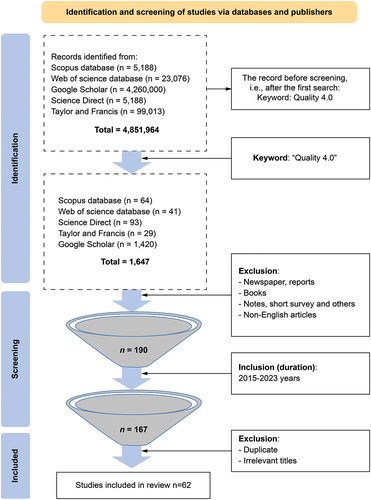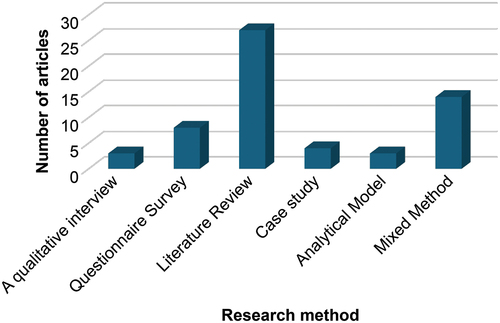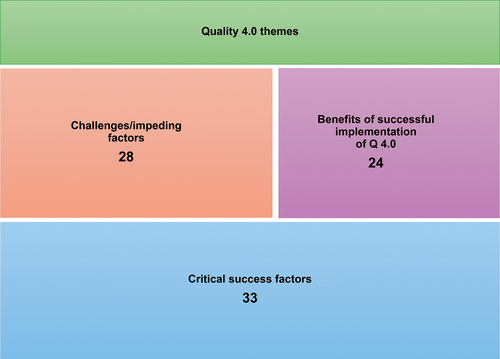ABSTRACT
Quality 4.0 (Q4.0), integrates new digital technologies with traditional quality management to improve operational excellence across industries. This literature review, adhering to PRISMA principles, examines papers from 2015 to 2023, focusing on the benefits, challenges, and critical success factors of Q4.0 implementation. Results highlight significant benefits, including enhanced operational efficiency and innovation, while identifying skill gaps, restrictions on resources, and substantial expenses in investment as major challenges. Strategic leadership and comprehensive frameworks are essential for overcoming these challenges and facilitating successful Q4.0 implementation. These insights are intended to assist organizations in navigating the intricate landscape of Quality 4.0.
1. Introduction
As Industry 4.0 emerges, contemporary organizations experience transformative shifts marked by heightened digitalization and automation. This digitalization paves the way for firms to integrate cutting-edge technology, fostering exceptional operational efficiency, performance, and ingenuity (Santos et al., Citation2021; Sony et al., Citation2020). Quality management, one of the crucial aspects of any organization, is changing in the era of Industry 4.0. The incorporation of Industry 4.0 technology into quality management is called Quality 4.0 (Q4.0). This concept was introduced by Dan Jacob who explained that Q4.0 merges novel technologies with traditional quality approaches (Sony et al., Citation2020). Nevertheless, multiple authors have since suggested alternative definitions for Q4.0 (Sader et al., Citation2022; Watson, Citation2019). Essentially, Q4.0 signifies the management of quality within the contemporary context of Industry 4.0. Consequently, Q4.0 encompasses the fusion of Industry 4.0’s innovative technologies with conventional quality management systems, tools, and techniques to attain exceptional performance, advanced operational excellence, and ideal innovation (Antony, Sony, et al., Citation2022; Radziwill, Citation2018).
With the ongoing digitalization and automation brought about by Industry 4.0, Q4.0 has become crucial in combining quality management with new technologies in the industrial and service industries (Thekkoote, Citation2022). This development demonstrates the continuous requirement to improve operational efficiency and fulfill increasing customer requirements, which necessitate rigorous monitoring of production processes to avoid errors and deviations (Antony, McDermott, et al., Citation2023; Jordan, Citation2020). Although Q4.0 has the potential to greatly enhance organizational capacities, the implementation and understanding of Q4.0 within organizations remain in their early stages (Antony, Sony, et al., Citation2022; Chiarini & Kumar, Citation2022). The current body of literature, although recognizing the growing interest in Q4.0, frequently provides partial perspectives and lacks an in-depth examination that combines the benefits, challenges, and critical success factors (CSFs) involved with its implementation.
Quality 4.0 aims to achieve optimal quality standards in various industries by incorporating digitalization into quality management systems (Salimova et al., Citation2020). Accordingly, a thorough understanding of both the practical and theoretical aspects of Q4.0 is essential for the successful implementation and integration of these systems in contemporary businesses. The use of visualization and conceptualization approaches has been recognized as crucial for understanding the complex elements of Q4.0 (Sony et al., Citation2021). Nevertheless, the comprehensive and systematic literature reviews on recent research regarding Q4.0 are lacking in the literature (Sureshchandar, Citation2023). Thus, this study addresses this gap by integrating existing research on the implementation of Q4.0. The review explores the relationship between technological advancements and quality management practices. It examines the benefits, challenges, and CSFs that arise from the development of quality approaches affected by the quality revolutions that occurred after the Industrial Revolution.
This systematic review aims to investigate two pivotal research questions: What are the benefits of implementing Q4.0? What are the challenges and CSFs associated with implementing it? The primary objective is to provide a strong framework that aids organizations in fully using the potential of Q4.0 to enhance competitiveness and foster innovation.
The remainder of this article is structured as follows: Section 2 outlines the method for conducting the systematic literature review. Section 3 presents the analysis and key findings. Section 4 discusses the descriptive findings derived from the review. Section 5 details the theoretical contributions and practical implications. Section 6 highlights the gaps and defines the potential avenues for future research. Finally, Section 7 concludes the study, presenting the research contributions and limitations.
2. Methodology
There is extensive literature on the topic of quality. In this study, the literature on Quality 4.0 implementation was reviewed systematically. A systematic literature review (SLR) is a methodical examination of existing publications that involves synthesizing the published data using a systematic technique (Tranfield et al., Citation2003). Kraus et al. (Citation2020) define an SLR as a comprehensive evaluation of current literature that employs a transparent and replicable approach for searching through the literature, evaluating its quality, and synthesizing it, while maintaining a high level of objectivity. SLR is a highly reliable strategy for navigating and analyzing a large body of literature. It produces high-quality evidence and is considered the most efficient approach for this purpose (Sadeghi Moghadam et al., Citation2021).
The SLR is important for researchers because it is effective in identifying deficiencies in previous scholarly works (Shamseer et al., Citation2015). However, before conducting an SLR, it is essential to develop a review procedure. This methodology aids in anticipating any possible issues, prevents arbitrary decision-making on inclusion and exclusion criteria, and minimizes redundant efforts (Shamseer et al., Citation2015). Accordingly, this study employed the PRISMA (Preferred Reporting Items for Systematic Reviews and Meta-analysis) declaration as its review protocol. The PRISMA protocol makes this review transparent to and reproduceable by other researchers.
2.1. Inclusion and exclusion criteria
The concept of ‘Quality 4.0’ was first introduced to the public in 2015 (Alzahrani et al., Citation2021). Thus, this review focused on scientific articles published between 2015 and 2023. Included in the study were several types of papers, including review articles, research articles, conference papers, and book chapter reviews. To be included in the study, the papers had to be published in English and contain the term ‘Quality 4.0’. Conversely, books, newspapers, reports, lecture notes, non-full articles, brief surveys, and articles that had not been published in English nor contained the term ‘Quality 4.0’ were excluded.
2.2. Sources of information for this study
The development of the search strategy began with an examination of pertinent data sources. Chadegani et al. (Citation2013), Dias et al. (Citation2022) and Reljić et al. (Citation2021) have identified Scopus and Web of Science as comprehensive scientific databases. Therefore, Web of Science and Scopus were chosen to ensure broad access to academic and conference publications. Scopus is a big scientific database that encompasses many journals. Likewise, Web of Science is one of the largest abstract and citation databases with thousands of peer-reviewed journals from various publishers, such as Elsevier, Springer, Emerald, Taylor & Francis, and IEEE across scientific, technological, medical, and social science disciplines (Kamble et al., Citation2018). However, between these two comprehensive databases, Scopus provides access to the more up-to-date articles. Additional sources that were relied on included Google Scholar, ScienceDirect, and Taylor and Francis.
2.3. Keyword selection
During the screening process, an extensive search strategy was used to find the most relevant literature on the implementation and utilization of Quality 4.0. The main term used was ‘Quality 4.0,’ alongside other relevant keywords to expand the range of the search and sort through the literature for related papers. These included ‘Quality 4.0’ OR ‘Digital Transformation’ OR ‘Digital/Smart Quality Management’ OR ‘QM Evolution,’ and others containing the number ‘4.0.’ were also used to sort through the literature for related papers AND (‘implementation’ OR ‘application’). The query was specifically constructed to identify the most relevant literature on the implementation and utilization of Quality 4.0. The search used relevant keywords and was organized to encompass a variety of words that were related to the many facets of Quality 4.0. To ensure the dependability and precision of the collected data, all the articles, regardless of their source, were evaluated using the same criteria. illustrates the methodology used for conducting the screening process.
3. Analysis and key findings
3.1. Descriptive statistics
A review and classification of the progress in the theoretical foundations of Q4.0 is necessary to provide an accurate picture of the current state of research and identify the most noteworthy subjects. Supplementary Table A.1 summarizes the 62 articles examined.
This section presents a comprehensive analysis of publications and their sources by year. A preliminary analysis was performed using the yearly publication output as a basis to obtain a comprehensive overview of the examined documents. From , there has been an overall increase in the number of Q4.0 articles over a period of several years. The year 2017 saw five published articles, noticeably rising in 2022 and reaching a peak of 16 articles. The largest annual rise was observed during the 2019–2020 period, resulting in a doubling of the number of articles from 7 to 13. This observation suggests a notable increase in the level of interest and the progress made on the subject matter during the year 2020. Moreover, the graphic illustrates a decrease in the number of publications in 2023. Nevertheless, it is important not to hastily observe this as a decline in interest. There may be other reasons that are causing this decrease, such as a potential conflict with the study’s criteria for including papers or the fact that most of the publications were not open access.
Figure 2. Annual production of research articles.
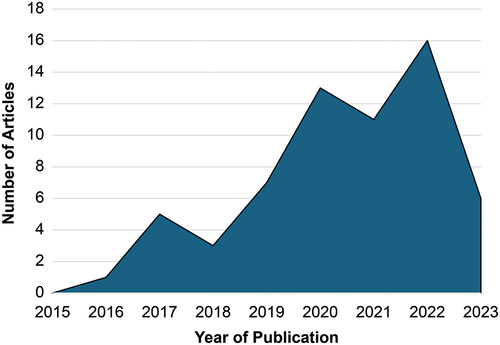
shows the important academic journals that have published papers about Q4.0. TQM Journal and Total Quality Management & Business Excellence are the primary journals with prominent articles on Q4.0. Most articles have been published in quality-focused journals. Additionally, the studies evaluated and examined in this review have been published in a diverse range of academic journals, encompassing manufacturing, operations, and sustainability fields. Thus, Q4.0 has an extensive and varied influence.
Figure 3. Number of publications per journal.
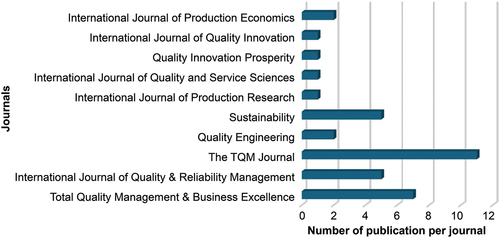
The reviewed papers used a range of research methodologies, as shown in . The most often used methods were literature review (n = 27), mixed method (n = 14), and questionnaire survey (n = 8).
3.2. Themes identified
presents the most common themes identified in the literature with number of papers reviewed for each theme, which include the benefits of Quality 4.0 implementation, challenges hindering factors and CSFs.
4. Discussion
4.1. Benefits of successful quality 4.0 implementation
One recurring topic in the papers relates to the benefits associated with the implementation of Q4.0. An analysis of 62 scholarly articles on Q4.0 revealed that 24 of them reported over 30 benefits (See Supplementary Table A.2.). The benefits frequently cited included cost reduction, error minimization, waste and defect reduction, enhancement of product-service or process quality, acceleration of decision-making processes, and improvement of performance and efficiency. In this review, ten leading benefits associated with implementing Quality 4.0 were identified. In short, implementing Quality 4.0
minimizes cost and quality-related issues such as errors, waste, and rework,
improves product/service or process quality,
increases the speed and quality of decision-making,
improves efficiency and enhances performance,
increases customer satisfaction,
improves transparency, traceability, and auditability,
reveals biases,
reveals opportunities for continuous improvement and new business models,
enhances workforce capability or capacity,
and improves the organization’s operational efficiency.
According to Antony, McDermott, et al. (Citation2022), the implementation of automation technology is expected to enhance the efficiency of technical systems, leading to a reduction in the marginal cost of production. For instance, Q4.0 will significantly decrease the expenses associated with subpar quality by minimizing the need for quality assurance, inspection, and addressing dependability issues in the field (Antony, McDermott, et al., Citation2022). For example, emerging technologies like blockchain have enhanced the accuracy and traceability of data, facilitating the swift retrieval of items in cases of quality concerns (Antony, McDermott, et al., Citation2023). Other benefits of implementing Q4.0 include increased productivity, greater operational efficiency, and increased customer satisfaction. These benefits serve as the motivation for the implementation of Q4.0. Javaid et al. (Citation2021) state that Q4.0 has extensive applications in the manufacturing sector. It automates inspection processes, lowers the cost of quality, aids in dynamic quality control, improves product performance, enhances business culture and partnerships, realigns quality functions, reshapes production procedures, streamlines the production of new products, automatically identifies defects, and facilitates proper operations of finished goods. Furthermore, it promotes environmental integrity and sustainable manufacturing by assisting operators in monitoring and preserving optimal levels of temperature, moisture, air, and water quality (Javaid et al., Citation2021). The resulting reduction in costs, associated with an increase in revenue, will lead to an improvement in the gross and net profit margins of firms.
However, despite the review of a substantial body of literature on the benefits of Q4.0, this study revealed many gaps in the literature. For instance, no study has discussed the possibility of variability in realizing these benefits across different industrial settings, or their causes (e.g., external factors such as organizational culture and technological readiness). These considerations may significantly influence the efficacy of Quality 4.0 implementations.
Furthermore, while benefits such as enhancing decision-making speed and quality are often cited, the socio-technical implications of these improvements remain unexplored. For instance, a more thorough examination is needed to properly understand the changes in workforce dynamics and job roles that come with Quality 4.0. This goes beyond just using technological advances.
Additionally, no study provides evidence of any failed cases of Q4.0 implementation. Various factors may contribute to this phenomenon, such as publication bias, which is the tendency of researchers and publishers to prioritize the publication of studies that yield positive or significant results while neglecting negative or null findings. This bias can yield an incomplete and potentially misleading representation of the available evidence on a given topic. Another factor could be the issue of selection bias in reporting, which is the tendency to highlight successful cases in publications to promote Q4.0 adoption, potentially resulting in an inadequate representation of failures. The phenomenon of misattribution of failures may be another factor, where failure is attributed to alternative factors instead of the Q4.0 implementation. The absence of clear metrics may impede the ability to identify Q4.0’s shortcomings, hindering the capacity to determine its success or failure. Evidently, the absence of a comprehensive evaluation of failed Q4.0 implementations or projects is a notable deficiency. Thus, the dissemination of such an analysis would be advantageous for organizations considering Q4.0 implementation in the future. Moreover, it is important for future research to thoroughly document and examine failed cases to provide an extensive viewpoint that can enable more knowledgeable decision-making in organizational settings.
4.2. Impeding factors or challenges for Quality 4.0 implementation
The in-depth review of existing academic studies on the notion of Q4.0 shows that numerous intricate challenges could impede organizations and practitioners in their Q4.0 implementation endeavors in various industries or fields. Supplementary Table A.3 presents the factors or challenges noted in 28 papers. The top five impeding factors include the skills gap, lack of resources, lack of leadership support and clear vision, high cost of investment and unclear return on investment (ROI) or cost of implementation, and lack of implementation knowledge and standardized frameworks for Quality 4.0.
Notably, the identified impeding factors exhibit interdependence and mutually affect one another. For instance, a lack of resources can hurt the capacity to deliver training and address the skills gap, whereas the absence of support from leadership can impede the allocation of resources and decision-making processes. Organizations are required to adopt a comprehensive and integrated approach to successfully address the challenges and formulate strategies that consider various interconnected factors concurrently.
Moreover, tacit knowledge (Dovleac, Citation2021) was given less attention as an impediment to Q4.0 implementation, despite the significant role played by knowledge management in various domains. Understanding and implementing tacit knowledge is pivotal in facilitating efficient decision-making, problem-solving, and innovation within the Q4.0 framework. Tacit knowledge can offer valuable insights, expertise, and intuition that are challenging to articulate or transmit through explicit knowledge. Further, it holds considerable importance in process optimization, quality improvement, and continuous innovation.
The insufficient consideration of tacit knowledge as a barrier to Q4.0 implementation may impede organizations’ capacity to fully utilize the potential advantages linked with this approach. Organizations must acknowledge the significance of tacit knowledge and formulate strategies to effectively capture, share, and leverage it. It may entail establishing platforms to share knowledge and collaborate, cultivating a culture that promotes the exchange of knowledge, and implementing mentoring and training initiatives to facilitate the transfer of tacit knowledge. This underscores the necessity for additional research and case studies in this area.
Due to the complex nature of these challenges, further empirical study is necessary to investigate the efficacy of the recommended solutions in different organizational contexts. Longitudinal studies have the potential to provide insights into the long-term impact of integrated strategies for addressing the skills gap, limited resources, and leadership challenges. Additionally, conducting research that specifically examines the effective transformation of tacit knowledge within Quality 4.0 frameworks might provide essential insights for improving organizational learning and innovation capabilities.
4.3. Critical success factors for Quality 4.0 implementation
CSFs for Quality 4.0 implementation emerge as a prevalent theme in the scholarly literature on Q4.0 implementation. Rockart (Citation1979) popularized the notion of identifying CSFs to ascertain specific managerial information requirements. Hence, these factors hold paramount significance in determining the success of an organization. Failure to attain the objectives linked with the factors may result in organizational failure. Further, Antony, Sony, et al. (Citation2023, b) noted that the CSFs offer organizations a structured approach to evaluate their preparedness and strategize for Q4.0 adoption. By considering these factors, firms can enhance their likelihood of achieving successful implementation and capitalize on the advantages offered by Q4.0 technologies and practices. Indeed, 18 different CSFs were identified across 33 research papers, with a predominant focus on the manufacturing sector. Supplementary Table A.4 presents the results.
The literature highlights the significance of training and rewards, as evidenced by 16 of the reviewed papers. The next step involves the demonstration of commitment and support from top management, as evidenced in nine scholarly papers. Other factors, such as strategic alignment and effective integration, are deemed to possess lesser significance ().
Figure 6. Top 10 critical success factors for Quality 4.0 implementation.
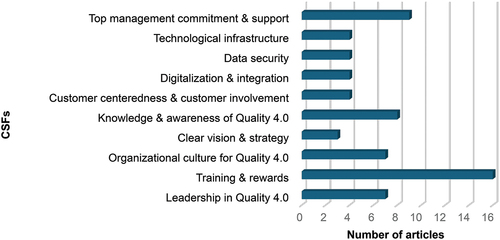
Nevertheless, CSFs exhibit variability across studies, organizations, and even countries. Certain CSFs identified as significant in previous research studies have diminished importance in subsequent studies. For instance, Závadská and Závadský (Citation2020) investigated industrial enterprises in the Slovak Republic, while Cho et al. (Citation2017) focused on manufacturing and service firms in the United States and China. Both revealed that factors such as customer-centeredness, supplier-centeredness, and collaboration did not rank among the top five factors for successfully implementing Q0.4. However, Sony et al. (Citation2021) and Cobelli and Chiarini (Citation2020) identified these factors as key CSFs. Given the challenge of identifying potential case studies, this review relied on expert judgment to estimate success factors.
This discussion emphasizes the intricate nature of adopting Quality 4.0 in different organizational and national contexts. It highlights the significance of comprehending the localized and sector-specific dynamics that impact the efficacy of various CSFs. The lack of consistent empirical evidence supporting these elements highlights the need for additional thorough and empirical studies to confirm and enhance the knowledge of CSFs associated with Quality 4.0 implementation. Hence, this study suggests that it is essential to elucidate the CSFs that are present in various nations and examine the top five factors in each country. The dearth of empirical research on CSFs, beyond the scarcity of tangible cases of successful implementations, presents an enormous challenge in the comparative analysis of CSFs across diverse nations. Further, several studies have identified additional success factors, though with limited attention and primarily from perspectives such as knowledge management (Dovleac, Citation2021; Sony et al., Citation2020) and integration of IT and OT (Maganga & Taifa, Citation2022). These factors have been derived from a review of the existing literature rather than an empirical investigation. Therefore, arguably, without conducting empirical studies on industrial or service organizations, it is challenging to ascertain the true significance of these success factors. Future research can aim to address these deficiencies by undertaking empirical investigations that probe CSFs for Q4.0 implementation across various countries and industries.
4.4. Conceptual framework
This study examines the dynamic relationship between CSFs, impeding factors, and the benefits of implementing Quality 4.0. It presents an integrated framework based on a review of the literature (). This framework outlines the key elements required for the successful implementation of Quality 4.0. The CSFs for achieving quality objectives in the context of Quality 4.0 include the following: (1) Training and rewards: Ensuring continuous learning and adaptation to new technologies and methods through training programs and incentivizing employees for their efforts. (2) Top management commitment and support: Driving quality initiatives by demonstrating strong commitment and providing the necessary resources and support. (3) Knowledge and awareness: Creating a culture of continuous improvement by fostering knowledge and awareness of Quality 4.0 across all levels of the organization. (4) Leadership in Quality 4.0: Guiding and influencing all levels of the organization toward achieving quality objectives through effective leadership. (5) Organizational culture for Quality 4.0: Promoting and sustaining quality improvement initiatives by fostering an adaptable and responsive organizational culture.
Figure 7. The conceptual framework.
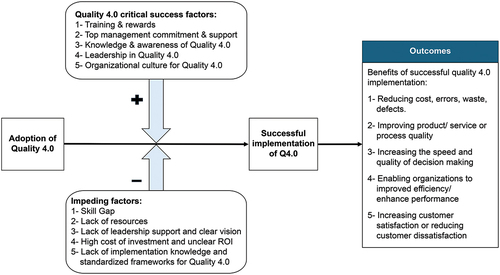
The framework also identifies challenges that can impede the implementation process and should be addressed proactively. These include the skills gap, which can restrict the ability of organizations to fully utilize Quality 4.0 technologies, the lack of resources, which can hinder the development and implementation of quality initiatives, a lack of leadership support and clear vision, which are crucial for guiding and sustaining the transformation process, the high cost of investment and unclear ROI, which can discourage investment in new technologies and practices, and the lack of implementation knowledge and standardized frameworks for Quality 4.0, which are essential for guiding the systematic deployment of Quality 4.0 practices.
A successful implementation of Quality 4.0 leads to a wide range of operational improvements that greatly enhance organizational performance. These results include a decrease in costs, errors, waste, and flaws, which directly enhance operational efficiency. In addition, enhancing the quality of a product, service, or process improves customer satisfaction and strengthens the reputation of the business. Increased decision-making speed and improved decision-making quality promote organizational agility and responsiveness, while enhanced performance and efficiency in organizational processes result in more effective resource usage. Moreover, Augmented Customer Satisfaction aids in keeping current clientele and enticing new ones through enhanced service quality and promptness. These outcomes are the tangible consequences of successfully adopting Quality 4.0. They may be accomplished by effectively addressing and overcoming the challenges connected with them via the supply of CSFs. Organizations may fully use the potential of Quality 4.0 to improve their operations and gain significant benefits by ensuring the presence of critical elements and effectively managing challenges.
The outlining of this conceptual framework is aimed at providing a systematic method for comprehending and navigating through the intricacies of Quality 4.0. By considering and addressing these factors, businesses can enhance their readiness for and utilize the benefits of the fourth Industrial Revolution in quality management.
5. Theoretical contributions and practical implications
This SLR significantly enhances our understanding of Quality 4.0 by analyzing its implementation and effects across many sectors. It combines conventional quality management methods with advanced digital technologies, offering a strong theoretical foundation for comprehending these combinations. The main theoretical contribution of the paper is an extensive review of the different benefits of Quality 4.0, including improved operational efficiency, innovation, and customer satisfaction. This directly addresses the major research questions regarding the benefits of implementing Quality 4.0.
Moreover, the study clearly outlines the main obstacles and CSFs related to the adoption of Quality 4.0. This paper elucidates the challenges that organizations may face and delineates the strategies that are required for achieving effective implementation. This review goes beyond addressing research questions to establish an intersection between the technical components of Quality 4.0 and the wider strategic management discussion. It emphasizes the crucial role of an organization’s cultural environment and leadership vision in the success of technological innovations.
In addition, the research highlights the need for continual improvement within the Quality 4.0 framework, elucidating how these technical developments might be used for continued improvements. For instance, practitioners must continuously upgrade their technology infrastructure and skills to remain competitive. The practical implications of this study include that firms should incorporate ongoing learning and development initiatives, with a specific emphasis on digital skills and lean management methods. These are crucial for optimizing the benefits of Quality 4.0. The findings in this study further motivate that organizations should create specific requirements and frameworks, using the identified critical success factors (CSFs), to improve the adoption procedures of Quality 4.0. Furthermore, participating in strategic planning meetings that integrate Quality 4.0 with wider business objectives guarantees that senior management is aligned and dedicated. Lastly, investing in sophisticated data analytics tools will facilitate faster decision-making and improve operational transparency. All these steps together create an atmosphere that is favorable for the successful integration of Quality 4.0, thus improving both the strategic and operational aspects of organizations.
This theoretical investigation not only addresses the current gaps in academic literature but also provides a basis for future empirical studies focused on examining the intricacies of quality management within the framework of digital transformation. The insights presented in this article can guide quality management professionals in the efficient implementation of Quality 4.0 principles in their operational procedures, thus enhancing operational efficiency and fostering innovation. These findings significantly contribute to both academic research and practical applications in quality management.
6. Gaps and future research directions
Within the dynamic realm of Quality 4.0, the incorporation of digital technology into traditional quality management presents positive improvements to the operational effectiveness and efficiency of organizations. Nevertheless, despite notable outcomes, there are still several unexplored domains that provide challenges and provide prospects for more investigation. To fill these gaps, it is essential to classify and analyze them methodically. Supplementary Table A.5 presents a systematic summary of the observed gaps in current Quality 4.0 research, categorized into groups. Each area encompasses unique facets of Quality 4.0, including methodological approaches and their effects on employees and organizational processes. The purpose of this well-structured presentation is to guide future research, to promote a more comprehensive understanding and effective use of Quality 4.0 in different sectors and cultural settings.
Future research that focuses on solving these gaps might make a substantial contribution to the existing body of knowledge on Quality 4.0. This will help businesses effectively use this advanced approach for quality management, leading to better operational and strategic results.
7. Conclusion
The Q4.0 concept signifies the integration of quality management concepts with the digital era. This investigation has revealed a growing interest in this subject, with noticeable advantages in organizations that have adopted it. Although there are evident benefits behind the adoption of technology in industries, it is important to acknowledge the challenges and obstacles, including skills deficiencies and substantial financial investments. The inclusion of specific publications, such as the TQM Journal and Total Quality Management & Business Excellence, in Q4.0 discussions indicates the scholarly and practical significance of this subject matter. Nevertheless, the extensive dependence on literature-on-literature reviews and expert opinions highlights the need for more empirical research conducted in real-world settings to enhance the comprehension of the complexity associated with Q4.0.
Comprehension of CSFs and obstacles, particularly when examined from a global standpoint and across many industries, can provide organizations with valuable insights to navigate their Q4.0 endeavors. The indisputable potential of Q4.0 to bring about revolutionary changes in several industries, ranging from higher education institutions to the healthcare sector, is evident. Nevertheless, conducting a thorough and evidence-based investigation of the discipline, with specific attention to its obstacles and the significance of implicit knowledge, can enhance its beneficial influence on worldwide sectors.
Supplemental Material
Download MS Word (77.3 KB)Disclosure statement
No potential conflict of interest was reported by the author(s).
Supplementary material
Supplemental data for this article can be accessed online at https://doi.org/10.1080/21693277.2024.2373739
Additional information
Funding
References
- Alzahrani, B., Bahaitham, H., Andejany, M., & Elshennawy, A. (2021). How ready is higher education for quality 4.0 transformation according to the LNS research framework? Sustainability, 13(9), 5169. https://doi.org/10.3390/su13095169
- Antony, J., McDermott, O., & Sony, M. (2022). Quality 4.0 conceptualization and theoretical understanding: A global exploratory qualitative study. The TQM Journal, 34(5), 1169–16. https://doi.org/10.1108/TQM-07-2021-0215
- Antony, J., McDermott, O., Sony, M., Toner, A., Bhat, S., Cudney, E. A., & Doulatabadi, M. (2023). Benefits, challenges, critical success factors and motivations of Quality 4.0–a qualitative global study. Total Quality Management & Business Excellence, 34(7–8), 827–846. https://doi.org/10.1080/14783363.2022.2113737
- Antony, J., Sony, M., Furterer, S., McDermott, O., & Pepper, M. (2022). Quality 4.0 and its impact on organizational performance: An integrative viewpoint. The TQM Journal, 34(6), 2069–2084. https://doi.org/10.1108/TQM-08-2021-0242
- Antony, J., Sony, M., McDermott, O., Jayaraman, R., & Flynn, D. (2023). An exploration of organizational readiness factors for Quality 4.0: An intercontinental study and future research directions. International Journal of Quality & Reliability Management, 40(2), 582–606. https://doi.org/10.1108/IJQRM-10-2021-0357
- Chadegani, A. A., Salehi, H., Yunus, M. M., Farhadi, H., Fooladi, M., Farhadi, M., & Ebrahim, N. A. (2013). A comparison between two main academic literature collections: Web of Science and Scopus databases. arXiv preprint arXiv:1305.0377. https://doi.org/10.48550/arXiv.1305.0377
- Chiarini, A., & Kumar, M. (2022). What is Quality 4.0? An exploratory sequential mixed methods study of Italian manufacturing companies. International Journal of Production Research, 60(16), 4890–4910. https://doi.org/10.1080/00207543.2021.1942285
- Cho, Y. S., Jung, J. Y., & Linderman, K. (2017). The QM evolution: Behavioral quality management as a firm’s strategic resource. International Journal of Production Economics, 191, 233–249. https://doi.org/10.1016/j.ijpe.2017.05.002
- Cobelli, N., & Chiarini, A. (2020). Improving customer satisfaction and loyalty through mHealth service digitalization: New challenges for Italian pharmacists. The TQM Journal, 32(6), 1541–1560. https://doi.org/10.1108/TQM-10-2019-0252
- Dias, A. M., Carvalho, A. M., & Sampaio, P. (2022). Quality 4.0: Literature review analysis, definition and impacts of the digital transformation process on quality. International Journal of Quality & Reliability Management, 39(6), 1312–1335. https://doi.org/10.1108/IJQRM-07-2021-0247
- Dovleac, R. (2021). Knowledge management systems in Quality 4.0. MATEC Web of Conferences (Vol. 342. pp. 09003). EDP Sciences. https://doi.org/10.1051/matecconf/202134209003
- Javaid, M., Haleem, A., Singh, R. P., & Suman, R. (2021). Significance of Quality 4.0 towards comprehensive enhancement in manufacturing sector. Sensors International, 2, 100109. https://doi.org/10.1016/j.sintl.2021.100109
- Jordan, T. (2020). Connected, intelligent, automated: The definitive guide to digital transformation and quality 4.0. Quality Progress, 53(8), 62.
- Kamble, S. S., Gunasekaran, A., & Gawankar, S. A. (2018). Sustainable Industry 4.0 framework: A systematic literature review identifying the current trends and future perspectives. Process Safety and Environmental Protection, 117, 408–425. https://doi.org/10.1016/j.psep.2018.05.009
- Kraus, S., Breier, M., & Dasí-Rodríguez, S. (2020). The art of crafting a systematic literature review in entrepreneurship research. International Entrepreneurship & Management Journal, 16(3), 1023–1042.. https://doi.org/10.1007/s11365-020-00635-4
- Maganga, D. P., & Taifa, I. W. R. (2022). Quality 4.0 conceptualisation: An emerging quality management concept for manufacturing industries. The TQM Journal, 35(2), 389–413. https://doi.org/10.1108/TQM-11-2021-0328
- Radziwill, N. M. (2018). Let’s get digital: The many ways the fourth industrial revolution is reshaping the way we think about quality. Quality Progress, 24–29. https://doi.org/10.48550/arXiv.1810.07829
- Reljić, V., Milenković, I., Dudić, S., Šulc, J., & Bajči, B. (2021). Augmented reality applications in industry 4.0 environment. Applied Sciences, 11(12), 5592. https://doi.org/10.3390/app11125592
- Rockart, J. F. (1979). Chief executives define their own data needs. Harvard Business Review, 57(2), 81–93.
- Sadeghi Moghadam, M. R., Safari, H., & Yousefi, N. (2021). Clustering quality management models and methods: Systematic literature review and text-mining analysis approach. Total Quality Management & Business Excellence, 32(3–4), 241–264. https://doi.org/10.1080/14783363.2018.1540927
- Sader, S., Husti, I., & Daroczi, M. (2022). A review of quality 4.0: Definitions, features, technologies, applications, and challenges. Total Quality Management & Business Excellence, 33(9–10), 1164–1182. https://doi.org/10.1080/14783363.2021.1944082.
- Salimova, T., Vatolkina, N., Makolov, V., & Anikina, N. (2020). The perspective of quality management system development in the era of industry 4.0. Humanities & Social Sciences Reviews, 8(4), 483–495. https://doi.org/10.18510/hssr.2020.8447
- Santos, G., Sá, J. C., Félix, M. J., Barreto, L., Carvalho, F., Doiro, M., Zgodavová, K., & Stefanović, M. (2021). New needed quality management skills for quality managers 4.0. Sustainability, 13(11), 6149. https://doi.org/10.3390/su13116149
- Shamseer, L., Moher, D., Clarke, M., Ghersi, D., Liberati, A., Petticrew, M., Shekelle, P., & Stewart, L. A. (2015). Preferred reporting items for systematic review and meta-analysis protocols (PRISMA-P) 2015: Elaboration and explanation. BMJ, 349(jan02 1), g7647–g7647. https://doi.org/10.1136/bmj.g7647
- Sony, M., Antony, J., & Douglas, J. A. (2020). Essential ingredients for the implementation of Quality 4.0: A narrative review of literature and future directions for research. The TQM Journal, 32(4), 779–793. https://doi.org/10.1108/TQM-12-2019-0275
- Sony, M., Antony, J., Douglas, J. A., & McDermott, O. (2021). Motivations, barriers and readiness factors for Quality 4.0 implementation: An exploratory study. The TQM Journal, 33(6), 1502–1515. https://doi.org/10.1108/TQM-11-2020-0272
- Sureshchandar, G. S. (2023). Quality 4.0 – a measurement model using the confirmatory factor analysis (CFA) approach. International Journal of Quality & Reliability Management, 40(1), 280–303. https://doi.org/10.1108/IJQRM-06-2021-0172
- Thekkoote, R. (2022). Enabler toward successful implementation of Quality 4.0 in digital transformation era: A comprehensive review and future research agenda. International Journal of Quality & Reliability Management, 39(6), 1368–1384. https://doi.org/10.1108/IJQRM-07-2021-0206
- Tranfield, D., Denyer, D., & Smart, P. (2003). Towards a methodology for developing evidence‐informed management knowledge by means of systematic review. British Journal of Management, 14(3), 207–222. https://doi.org/10.1111/1467-8551.00375
- Watson, G. H. (2019). The ascent of quality 4.0. Quality Progress, 52(3), 24–30. https://asq.org/quality-progress/articles/the-ascent-of-quality-40?id=8321f828c7c44634b996b2b1ba25a315
- Závadská, Z., & Závadský, J. (2020). Quality managers and their future technological expectations related to Industry 4.0. Total Quality Management & Business Excellence, 31(7–8), 717–741. https://doi.org/10.1080/14783363.2018.1444474

